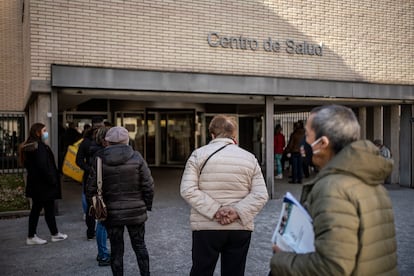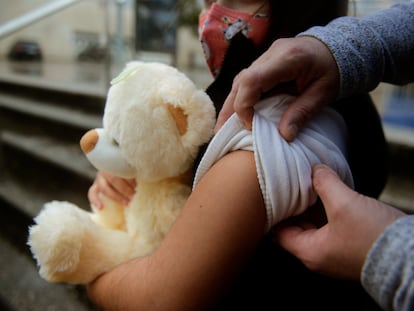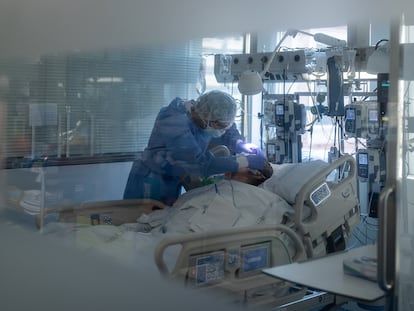Coronavirus surge in Spain: 3% of population has tested positive in the past two weeks
The Health Ministry reported 292,394 new infections on Monday and added 202 deaths to the official toll, which now exceeds 90,000

The omicron variant of the coronavirus continues to break all records in Spain since the pandemic hit in March 2020. The Spanish Health Ministry on Monday reported 292,394 new coronavirus infections, pushing the 14-day incidence rate to 2,989 cases per 100,000 inhabitants – a rise of 267 points since Friday, when the last data was released. This means that one in every 33 people in Spain – or 3% of the population – has tested positive for Covid-19 in the last two weeks. While all indicators point at a slowdown in the rate of the spread, the figures are still very high, with 790,000 new cases detected just last week.
The number of hospital admissions for Covid-19 is also on the rise. There are currently 16,496 Covid-19 patients in hospital (2,070 more than on Friday), while admissions to intensive care units (ICUs) stand at 2,220, meaning Covid-19 patients now occupy 24% of all ICU beds. The Health Ministry also added 202 deaths to the official toll, which now exceeds 90,000.
Meanwhile, contagion rates in Spain’s regions – which are in charge of their healthcare systems, Covid-19 vaccination drives and coronavirus restrictions – are at unprecedented levels. In Navarre, for example, the 14-day incidence rate in the 20-29 age group exceeds 10,000 cases per 100,000. This means that more than one in every 10 people in this group has tested positive in the last two weeks.
Comparing the coronavirus situation in each region, however, has become less useful as healthcare systems come under greater pressure. Some regions have decided to stop tracing contacts or actively look for possible infections.
José Luis Alfonso, the head of preventive medicine at Valencia’s General Hospital, explains that the contagions that took place on Christmas Eve and New Year’s Eve are straining Spain’s hospitals. This is the latest development of the sixth coronavirus wave which took hold of the country two months ago following the arrival of the new, highly transmissible omicron variant. “The patients that are coming in are linked to large meetings and social gatherings as the origin of their infections,” said Alfonso. “They are events that we can assume won’t continue to happen, meaning it is likely that we are now in the midst of the peak of contagion and in a few more days we will be at this point with hospitalizations.”
We need to stop dedicating our scant resources to minor and asymptomatic cases that don’t need itJosé Miguel Cisneros, head of infectious diseases at Virgen del Rocío Hospital
The rise in coronavirus cases has pushed Spain’s primary healthcare system to the breaking point. This means it will be difficult to precisely establish the moment in which Spain reaches the peak of the sixth wave. For this reason, experts agree that it will be more useful to look at Covid-19 hospital admissions to identify a change in the upward trend. With the health system unable to diagnose all patients due to the overwhelming numbers, regions such as Catalonia and Madrid are including positive results from home antigen tests in the official count. Nearly half of Spain’s 17 regions are also working with pharmacies – which sell antigen tests – to continue to identify new cases. However, a growing number of asymptomatic and minor cases are being left out of the official count. It is so far impossible to quantify how many infections fall into this category.
After easing several coronavirus measures, the Health Ministry is finalizing a plan for a new Covid-19 surveillance system that will mirror the one that has been used for years to monitor the flu. The new system will extrapolate numbers from a statistically significant sample, rather than rely on daily reporting of each and every diagnosed infection.
The plan is not set to come into force until after the end of the sixth wave, but a growing number of experts are calling for its introduction to be fast-tracked. They argue the health system is overloaded and cannot identify or diagnose all cases, and even less carry out contact tracking on the more than one million positive infections reported each week.
“It doesn’t make sense to maintain a strategy that cannot be kept because it leads to frustration and exasperates citizens,” said José Miguel Cisneros, the head of infectious diseases at Virgen del Rocío Hospital in Seville. “It is better that we urgently adapt it to the current situation and stop dedicating our scant resources to all minor and asymptomatic cases that don’t need it.”
“There are many other sick people who require our assistance and they find the system overwhelmed,” Cisneros added. “The diagnosis and the monitoring of what are clinically no more than colds cannot take up so much of the system’s resources. And this also includes sick leave. With the elevated transmission rates and the minor severity of the large majority of cases thanks to vaccination, there is now the risk that the measures from the current strategy are causing more harm than the virus itself.”
In Spain’s schools, for example, there are concerns about staff shortages due to coronavirus cases among teachers. According to a count by EL PAÍS, 11,380 teachers are on sick leave due to Covid-19 and other illnesses in 15 regions, the equivalent of 1.6% of teaching staff.
Tu suscripción se está usando en otro dispositivo
¿Quieres añadir otro usuario a tu suscripción?
Si continúas leyendo en este dispositivo, no se podrá leer en el otro.
FlechaTu suscripción se está usando en otro dispositivo y solo puedes acceder a EL PAÍS desde un dispositivo a la vez.
Si quieres compartir tu cuenta, cambia tu suscripción a la modalidad Premium, así podrás añadir otro usuario. Cada uno accederá con su propia cuenta de email, lo que os permitirá personalizar vuestra experiencia en EL PAÍS.
¿Tienes una suscripción de empresa? Accede aquí para contratar más cuentas.
En el caso de no saber quién está usando tu cuenta, te recomendamos cambiar tu contraseña aquí.
Si decides continuar compartiendo tu cuenta, este mensaje se mostrará en tu dispositivo y en el de la otra persona que está usando tu cuenta de forma indefinida, afectando a tu experiencia de lectura. Puedes consultar aquí los términos y condiciones de la suscripción digital.
More information
Últimas noticias
Trump claims peace in Ukraine is near, but Moscow suggests otherwise
A survivor’s account of the Interoceanic Train accident: ‘We were scared because of the speed on the curve’
The Interoceanic Train, the Mexican alternative to the Panama Canal
What is known about the Interoceanic Train derailment in Oaxaca
Most viewed
- Oona Chaplin: ‘I told James Cameron that I was living in a treehouse and starting a permaculture project with a friend’
- Reinhard Genzel, Nobel laureate in physics: ‘One-minute videos will never give you the truth’
- Why the price of coffee has skyrocketed: from Brazilian plantations to specialty coffee houses
- Pablo Escobar’s hippos: A serious environmental problem, 40 years on
- Chevy Chase, the beloved comedian who was a monster off camera: ‘Not everyone hated him, just the people who’ve worked with him’











































